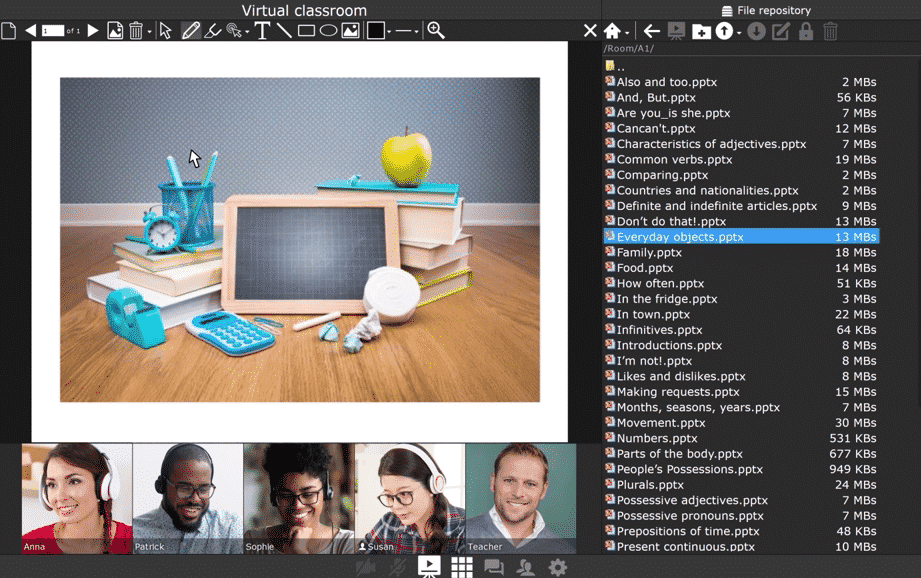Of late, interactive whiteboards have become a common element within the educational field, so much so that they have led to a paradigm shift in the way of understanding the teaching and learning processes. And so it is that, although the technology has existed for more than two decades, its use has only grown exponentially in recent years.
A virtual or interactive whiteboard is defined as one in which digital content is projected on a screen that, in turn, allows the student to interact directly on it, either by touch or with a pointer. All this allows the student to use the screen to interact with the training programs; write on it, underline, highlight parts of the text or be able to enlarge the images, among other things.
All these characteristics mean that the use of interactive whiteboards in virtual classrooms has great benefits and advantages that positively affect both students and teachers. Thanks to their use, all students can actively participate in their own learning process. This favors their collaboration with the content taught and improves the development of skills and abilities that will help achieve higher academic performance.
At CAE we know the importance of new technologies in the educational field in general and, more specifically, in virtual classrooms whose purpose is to accelerate the learning of a new language through the active participation of students in the learning process. In this article we analyze why it is important to use interactive whiteboards in virtual classrooms and what the benefits and advantages are.

Why are interactive whiteboards important in virtual classrooms?
The interactive whiteboard is a tool that can be successfully implemented at any educational stage, so it is not recommended that any learning institution ignore its use. In the case of virtual classrooms, interactive whiteboards provide flexibility in education and allow the teacher to analyze, design and implement functions to achieve a desired pedagogical result.
Here are the three most important benefits of using interactive whiteboards.
Interactive learning and easy handling
Students benefit from having a large interactive surface that is responsive to an electronic pen or even a finger. This facilitates the understanding of the subject because through touching, drawing or writing on the board they understand the contents in a better way.
In addition, interactive whiteboards are intuitive and easy to use. If any of your students have visual difficulties, they can benefit from the possibility of increasing the size of texts and images, as well as the possibilities of manipulating objects and symbols. If in the classroom, as a teacher, you have a student with hearing problems, do not worry, because virtual whiteboards offer the possibility of using visual presentations or the use of sign language simultaneously.
Their interactivity and easy handling stimulate learning, increase motivation and improve performance in areas that could previously be challenging.
They are a vast resource bank and their effectiveness is proven
Interactive whiteboards offer very powerful teaching resources and are an inexhaustible source of multimedia information. Thanks to these characteristics, students are attentive in the classroom, their understanding of the content is improved, they learn better and they remember it. In short, this technological tool helps to capture students’ attention to a greater extent, facilitating the follow-up of the teachers’ explanations.
Its integration in virtual classrooms has turned out to be very effective because it has become a transparent tool within the teaching-learning process.
Interactive whiteboards make it easy for the teacher to structure the lessons
All teachers need to know the students they are addressing in order to preempt any difficulties and thus be able to prepare for them in their planning. A teacher with an interactive whiteboard can easily formulate and plan the lesson in advance.
He can program specific learning tasks, such as labeling parts of a picture and matching words with their respective meanings. This is where the benefits of interactive whiteboards in virtual classrooms come in handy. Students can understand and learn how to handle new assignments and teachers will find it easy for students to learn new concepts.
In addition to these benefits, there are also other important factors which that virtual whiteboards offer. These are:
- Classes are more attractive to teachers and students.
- The process of interaction in the class is increased.
- It is a flexible resource for other teaching strategies.
- You have direct and immediate access to any audiovisual resource.
- There is no need to take notes, as everything appears on the screen.
If you want to know more about how at CAE we put our vocation in educational e-learning solutions into practice, you can contact us for an obligation-free consultation and benefit from the extensive range of online teaching solutions that we can make available to you.

